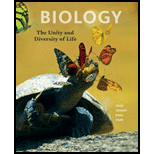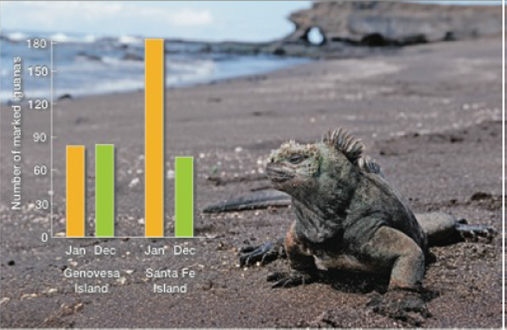
Iguana Decline In 1987, Martin Wikelski began a long-term study of marine iguanas in the Calapágos Islands. He marked iguanas on two islands—Genovesa and Santa Fe—and collected data on how their body size, survival, and reproductive rates varied over time. He found that because iguanas eat algae and have no predators, deaths usually result from food shortages, disease, or old age. In January 2001, an oil tanker ran aground and leaked a small amount of oil into the waters near Santa Fe. FIGURE 44.17 shows the number of marked iguanas that Wikelski and his team counted in their study populations just before the spill and about a year later.

FIGURE 44.17 Shifting numbers of marked marine iguanas on two Galápagos islands. An oil spill occurred near Santa Fe just after the January 2001 census (orange bars). A second census was carried out in December 2001 (green bars).
3. Wikelski concluded that changes on Santa He were the result of the oil spill, rather than sea temperature or other climate factors common to both islands. How would the census numbers be different from those he observed if an adverse event had affected both Islands?
Want to see the full answer?
Check out a sample textbook solution
Chapter 44 Solutions
Biology: The Unity and Diversity of Life (MindTap Course List)
- Iguana Decline In 1987, Martin Wikelski began a long-term study of marine iguanas in the Galpagos Islands. He marked iguanas on two islandsGenovesa and Santa Feand collected data on how their body size, survival, and reproductive rates varied over time. He found that because iguanas eat algae and have no predators, deaths usually result from food shortages, disease, or old age. In January 2001, an oil tanker ran aground and leaked a small amount of oil into the waters near Santa Fe. FIGURE 44.3 shows the number of marked iguanas that Wikelski and his team counted in their study populations just before the spill and about a year later. FIGURE 44.3 Shifting numbers of marked marine iguanas on two Galpagos islands. An oil spill occurred near Santa Fe just after the January 2001 census (orange bars). A second census was carried out in December 2001 (green bars). How much did the population size on each island change between the first and second census?arrow_forwardIguana Decline In 1987, Martin Wikelski began a long-term study of marine iguanas in the Galpagos Islands. He marked iguanas on two islandsGenovesa and Santa Feand collected data on how their body size, survival, and reproductive rates varied over time. He found that because iguanas eat algae and have no predators, deaths usually result from food shortages, disease, or old age. In January 2001, an oil tanker ran aground and leaked a small amount of oil into the waters near Santa Fe. FIGURE 44.3 shows the number of marked iguanas that Wikelski and his team counted in their study populations just before the spill and about a year later. FIGURE 44.3 Shifting numbers of marked marine iguanas on two Galpagos islands. An oil spill occurred near Santa Fe just after the January 2001 census (orange bars). A second census was carried out in December 2001 (green bars). Wikelski concluded that changes on Santa Fe were the result of the oil spill, rather than sea temperature or other climate factors common to both islands. How would the census numbers be different from those he observed if an adverse event had affected both islands?arrow_forwardPeter and Rosemary Grant of Princeton University have studied the ecology and evolution of finches on the Galapagos Islands since the early 1970s. They have shown that finches with large bills (as measured by bill depth; see Figure) can eat both small seeds and large seeds, but finches with small bills can only eat small seeds. In 1977, a severe drought on the island of Daphne Major reduced seed production by plants. After the birds consumed whatever small seeds they found, only large seeds were still available. The resulting food shortage killed a majority of the medium ground finches (Geospizafortis) on Daphne Major; their population plummeted from 751 in 1976 to just 90 in 1978. The Grants research also documented a change in the distributions of bill depths in the birds from 1976 to 1978, as illustrated in the graphs to the right. In light of what you now know about the relationship between bill size and food size for these birds, interpret the change illustrated in the graph. What type of natural selection does this example illustrate? Source: P. R. Grant. 1986. Ecology and Evolution of Darwins Finches. Princeton University Press.arrow_forward
- Shrimp fishing off the coast of Georgia was closed in 2001, due to a drastic reduction in the shrimp population. Landings of blue crab plummeted in 2002 and 2003, as five years of drought and greatly reduced freshwater flow from underground aquifers led to increased salinity in coastal estuaries. These habitats between open ocean and fresh water are the “nurseries’ for many marine animals. Using information you learned in this lab, speculate about possible causes for the decline in shrimp and blue crab populations.arrow_forwardMilkfish (Chanos chanos) is the only fish species that belongs to Family Chanidae which is nearly related to tuna and salmon due to its fusiform shape and migratory nature. It is widely distributed in the Indo-pacific region and abundantly collected in the South and Southeast Asian, and West Pacific Regions. Milkfish is one of the most commercially important fish species in the Philippines. Milkfish reach sexual maturity (approximately 1.5m length and 20 kg weight) in five years in large floating cages, but may take 8-10 years in ponds and concrete tanks. In the natural environment, milkfish populations near the coral reefs spawn during warm months of the year while populations near the equator spawn year-round. First-time spawners produce fewer eggs but larger and older broodstocks produce as many eggs as wild adults of similar size. Broodstocks of about 8 years old and about 6 kg produce 3-4 million eggs. Juvenile and adults milkfish eat a wide variety of relatively soft and small…arrow_forwardPart A)DR TJ freaks out because she doesn’t hear any cicadas singing in January. If she understood the biology of these animals she would know that was because adult cicadas do not emerge from underground until summer! Dr TJ should have a better understanding of the importance of ___ in studying ecology. timing spatial distributions none of these Part B)If I read 50 papers on phenotypic plasticity in sea stars and they all showed that these animals exhibit behaviors that allow them to persist under temperature stress, this would be an example of ____ in science. detection measurement repeatabilityarrow_forward
- Shrimp fishing off the coast of Georgia was closed in 2001, due to a drastic reduction in the shrimp population. Landings of blue crab plummeted in 2002 and 2003, as five years of drought and greatly reduced freshwater flow from underground aquifers led to increased salinity in coastal estuaries. These habitats between open ocean and fresh water are “nurseries” for many marine animals. Speculate about possible causes for the decline in shrimp and blue crab populations.arrow_forwardA sardine shoaling behavior shown below is observed in sardine fishing grounds in the country such as the Zamboanga Peninsula. Shoaling behavior happens when a massive number of sardines arrive to feed in coastal areas associated with high primary production due to upwelling. This massive number of arrivals also means a sardine feast for its predators such as tuna, barracuda, other piscivorous pelagic fish as well as sharks. What do you think is the adaptive value of shoaling behavior? How does "arriving in massive numbers" contribute to better chances of survival against an ensuing feast of predators?arrow_forwardChoose True for yes or choose false for no for each statement 1) Gray whales may experience a shift in their realised niche True or false 2) Killer whales may no longer prey on gray whales True or false 3) Extirpation of the killer whale will not substantially affect the structure of this foodweb True or falsearrow_forward
- Introduction The Rock Pocket Mouse The rock pocket mouse, Chaetodipus intermedius, is a small, nocturnal animal found in the deserts of thesouthwestern United States. Most rock pocket mice have a sandy, light-colored coat that enables them to blendin with the light color of the desert rocks and sand on which they live. However, populations of primarily dark-colored rock pocket mice have been found living in areas where the ground is covered in a dark rock calledbasalt caused by geologic lava flows thousands of years ago. Scientists have collected data from a population ofprimarily dark-colored mice living in an area of basalt called the Pinacate lava flow in Arizona, as well as from anearby light-colored population. Researchers analyzed the data from these two populations in search of thegenetic mutation responsible for the dark coat color. Their analyses led to the discovery of a mutation in theMc1r gene that is involved in coat-color determination. The MC1R Gene Two pigments…arrow_forwardWhat is the main idea of this text? In the years right after the invasion, zebra mussels evolved and adapted to the Hudson River ecosystem. In the years right after the invasion, zebra mussels evolved and adapted to the Hudson River ecosystem. In the years right after the invasion, zebra mussels caused a number of changes in the Hudson River ecosystem and food web. In the years right after the invasion, zebra mussels caused a number of changes in the Hudson River ecosystem and food web. In the years right after the invasion, zebra mussels did not have a major impact on the Hudson River ecosystem or food web. In the years right after the invasion, zebra mussels did not have a major impact on the Hudson River ecosystem or food web. At first, zebra mussels did not have any impact on the Hudson River ecosystem, but their impact increased over timearrow_forwardBurmese pythons are native to southeast Asia but have become popular pets over the last few decades. Over time, escaped and released pythons have made their way into Everglades National Park, Florida, USA where they have displaced many native What term best describes the Burmese pythons in Everglades National Park?arrow_forward
 Biology: The Unity and Diversity of Life (MindTap...BiologyISBN:9781337408332Author:Cecie Starr, Ralph Taggart, Christine Evers, Lisa StarrPublisher:Cengage Learning
Biology: The Unity and Diversity of Life (MindTap...BiologyISBN:9781337408332Author:Cecie Starr, Ralph Taggart, Christine Evers, Lisa StarrPublisher:Cengage Learning Biology: The Unity and Diversity of Life (MindTap...BiologyISBN:9781305073951Author:Cecie Starr, Ralph Taggart, Christine Evers, Lisa StarrPublisher:Cengage Learning
Biology: The Unity and Diversity of Life (MindTap...BiologyISBN:9781305073951Author:Cecie Starr, Ralph Taggart, Christine Evers, Lisa StarrPublisher:Cengage Learning Biology Today and Tomorrow without Physiology (Mi...BiologyISBN:9781305117396Author:Cecie Starr, Christine Evers, Lisa StarrPublisher:Cengage Learning
Biology Today and Tomorrow without Physiology (Mi...BiologyISBN:9781305117396Author:Cecie Starr, Christine Evers, Lisa StarrPublisher:Cengage Learning Concepts of BiologyBiologyISBN:9781938168116Author:Samantha Fowler, Rebecca Roush, James WisePublisher:OpenStax College
Concepts of BiologyBiologyISBN:9781938168116Author:Samantha Fowler, Rebecca Roush, James WisePublisher:OpenStax College Biology (MindTap Course List)BiologyISBN:9781337392938Author:Eldra Solomon, Charles Martin, Diana W. Martin, Linda R. BergPublisher:Cengage Learning
Biology (MindTap Course List)BiologyISBN:9781337392938Author:Eldra Solomon, Charles Martin, Diana W. Martin, Linda R. BergPublisher:Cengage Learning Biology: The Dynamic Science (MindTap Course List)BiologyISBN:9781305389892Author:Peter J. Russell, Paul E. Hertz, Beverly McMillanPublisher:Cengage Learning
Biology: The Dynamic Science (MindTap Course List)BiologyISBN:9781305389892Author:Peter J. Russell, Paul E. Hertz, Beverly McMillanPublisher:Cengage Learning





